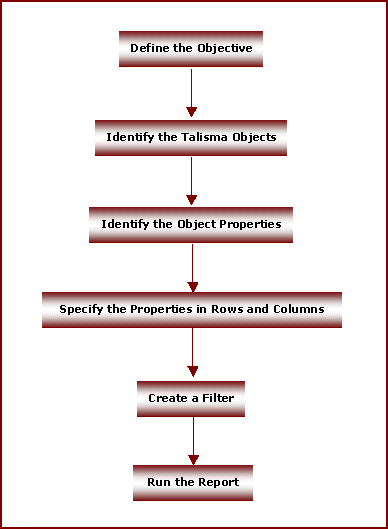About Talisma Reports
Talisma reports are of two types: Cross Tab and Drill Down. The Talisma Report wizard enables you to generate these reports.
There are certain common steps for generating these reports and these are represented in the following figure. Taking into account the typical reports that are generated in an organization, this figure guides you through the different stages in constructing a Talisma report. See the table below the graphic for more information.

Steps for generating Talisma Reports
|
Step |
Description |
|
Define the Objective |
As an analyst, you need to define the objective for generating the report. For example, your objective can be to analyze the performance levels of sales representatives. At this stage you can also identify the Talisma functionality to which the report is related. Based on the objective of the report, you need to select the appropriate report type. For example, to obtain a weekly breakdown of sales figures, you can create a Drill Down report. To study the impact of pending Interactions on your Contacts, you can generate a Cross Tab report. |
|
Identify the Talisma Objects |
Based on the objective of the report, identify the Talisma Objects on which the report must be generated. You need to identify a base Object, in addition to which, you can select one or more related Objects depending on the type of report. For example, when you want to generate a report to track the performance of sales representatives, you can use Opportunity as the base Object. The representative with the maximum count of Opportunities can be considered a good performer. To track the customer associated with each Opportunity, you can select Account as the related Object. In this example, you have identified a base Object and one related Object. |
|
Identify Object Properties |
Having identified the base Object and related Object, you need to identify the Properties to be included in the report. For example, if you selected Opportunity as the base Object for the report, you need to specify Owner (which is a Property of the Opportunity Object) to retrieve the name of the sales representative who generated the Opportunity. Similarly, if you selected Interaction as the base Object, you can select Assigned to (which is a Property of the Interaction Object) to extract the name of the Interaction owner. At this stage, you need a clear understanding about what every Object and Property in Talisma translates into, in the business scenario. For example, the Account Object in Talisma represents an organization with which you maintain a business relationship, and the Property Account Owner translates into the name of the manager who handles the Account. |
|
Specify Rows and Columns |
At this stage, you need to visualize the output of the report, and identify the parameters that must be displayed along the rows and columns of the report. For example, when you are generating a sales report, you might want the report to display the names of the sales representatives in rows, and the corresponding number of Opportunities generated by them along the columns of the report. You must specify this in the Talisma Report wizard while creating the report. |
|
Define a Filter |
You can define criteria using Filters, based on which specific information will be retrieved and displayed in the report. For example, to view the number of sales Opportunities generated in the past three months, you can define a Filter that restricts the data displayed in the report to the specified period. When you do not define a Filter, the report displays information for the period from the time Talisma was first installed. It is recommended that you define a Filter in order to reduce the run time of the report. |
|
Run the Report |
Having specified all the required information in the Talisma Report wizard, you are ready to run the report. You can specify additional options such as saving the report in a user-defined folder and enabling the automatic refresh option. You can select the report and run it at any time using the Run Latest option in Talisma Analytics. |
The following topics introduce you to Cross Tab Reports.